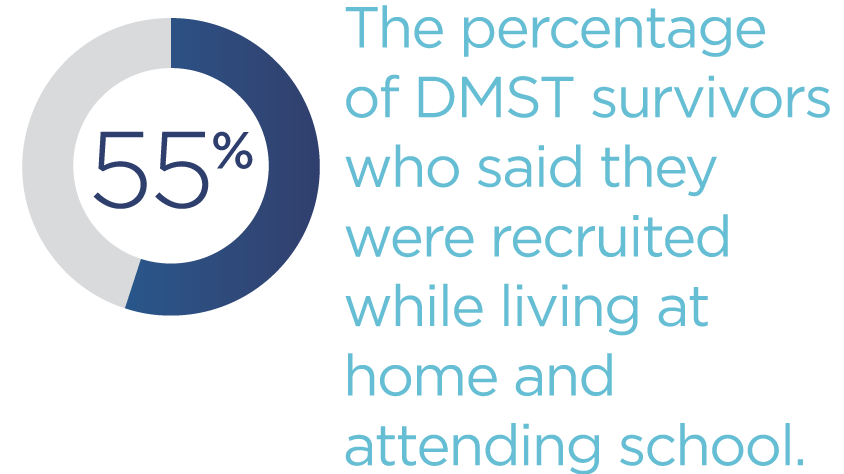Training Security Guards to Identify Sex Trafficking Victims
Billions of dollars each year go to perpetrators of child sex trafficking. Also known as domestic minor sex trafficking (DMST), this crime encompasses commercial sex exploitation of children through buying and selling of sexual services, sexual abuse images, live sexual abuse, and stripping. Besides the moral obligation to partner with government and organizations (NGOs) to combat DMST, U.S. businesses are criminally and civilly liable as facilitators for indirectly, but knowingly, profiting from the venture in reckless disregard to use of a minor, according to the Trafficking Victims Protection Reauthorization Act of 2008. Corporations should consider awareness training as one of the best ways to protect themselves from liability.
Ideally, security managers would incorporate a training requirement for their personnel, particularly because sex trafficking victims are most likely to cross paths with security guards posted in locations corresponding to five critical infrastructure sectors: transportation, healthcare, commercial facilities, government facilities, and the food sector.
Minor victims are transferred from source cities or states to destination cities or states using various transportation systems (aviation, mass transit and passenger rail, highway and motor carrier). Eventually traffickers will allow minor victims to seek medical or dental care in healthcare and public health settings, particularly when pain, injuries, pregnancy, or sexually transmitted disease prevents them from working. Various legitimate commercial facilities (gaming, lodging, outdoor events, public assembly, real estate, retail, sports leagues), government facilities (military facilities, embassies), and the food sector (restaurants) are used to feed, clothe, advertise, sell, and exploit the minor victim.
Security personnel need to understand two of the prominent myths regarding sex trafficking victims and learn the players involved in these criminal organizations in order to apply concepts in formal training.
MYTH 1: Child sex trafficking victims are girls from poor countries.
Children from across the United States—rural, suburban, and urban areas in all 50 states and Washington, D.C.—are victims of sex trafficking. The United States is not only a country of source—it is also a transit and top destination for minor sex trafficking and exploitation victims, particularly for prostitution and child sexual abuse material production and distribution.
Traffickers target vulnerable minors—who are runaways, throwaways, at-risk, abused, neglected, addicted, marginalized, undocumented, or impoverished. Children of color are often disproportionally represented in these populations. According a 2018 study from the Connecticut Department of Children and Families, 73 percent of 210 referrals about trafficking were children of color. Many of the children trafficked for commercial sexual exploitation are girls, but a 2016 study funded by the U.S. Department of Justice estimated about 36 percent are boys. Victims are from all socioeconomic, ethnic, and racial groups.
MYTH 2: Children are abducted by strangers and held hostage in chains.
A 2011 study by Kimberly Kotrla and Beth Ann Wommack analyzing 115 minor sex trafficking cases from 2000 to 2009 found that kidnapping accounted for less than 10 percent of incidents. In 2018, anti-exploitation technology organization Thorn reported that 55 percent of survivors said they were recruited while living at home and attending school.

The Polaris Project indicates that traffickers’ control over victims is psychological—gained through abuse (physical, sexual, emotional, economic), manipulation, social isolation, drug addiction, and feigned affection. Thus, even when they are not under the watchful eyes of their controller, their mental chains prevent them from telling anyone or escaping.
DMST Organizations
According to a 2009 study, Domestic Minor Sex Trafficking: A Network of Underground Players in the Midwest by Celia Williamson and Michael Prior, there are seven players with specific roles in the domestic minor sex trafficking organization—connectors, recruiters, groomers, traffickers, bottoms, watchers, and wife-in-laws. The involvement of the trafficking controller depends on the size of the sex trafficking operation. Controllers who work alone perform most roles with some assistance from a “trusted” (unpaid) current victim, whereas those who are the head of a group have paid trafficking associates and/or trusted victims to fill most of the roles.
Connectors. Associates or trusted victims locate potential victims and introduce them to special people—typically recruiters or traffickers—who will provide money, fame, love, etc. Connectors are compensated with cash or other benefits (e.g., drugs, club entry).
Recruiters. Associates or trusted victims convince new victims to join the stable by glamorizing the lifestyle and building up the reputation of the controller.
Groomers. Associates or trusted victims teach new victims how to be prostitutes—from how to dress to how to negotiate with customers. Often the groomer works for the trafficker as part of the group, but there are some who are paid a fee just to train and turn over the victims to the trafficker.
Traffickers. The traffickers control victims for the purpose of sexual exploitation and arrange for the victims in the stable to earn money through sex acts. To gain compliance over victims—male traffickers most often use a Romeo (false romance/boyfriend con) tactic, whereas female traffickers typically use a Mother (helping the child feel connected in a family way) tactic. Alternatively, guerrilla (brute force) tactics may be used on victims of both male and female traffickers.
Bottoms. These trusted victims are completely obedient, know the most about the business, and have been in the trafficker’s stable the longest. As the second in command, they typically control the rest of the stable—including administering punishments, purchasing clothes, advertising victims, and ensuring that victims meet their quotas. Victims may perceive the bottom and trafficker to be in a “relationship,” and they may act like a “stable couple.”
Watchers. Associates or trusted victims transport victims, ensure they safely make it to/from their venue (e.g., truck stop, strip club, hotel), and collect money earned.
Wife-in-laws. Trusted victims controlled by same trafficker are informally paired together for housing purposes. They give all of their earnings to the trafficker, who in turn provides financially for their needs.
Formal Training
To reduce corporate liability, employees must be formally trained to identify victims using industry-specific programs by nonprofit NGOs tasked with this responsibility (e.g., Polaris Project; National Human Trafficking Training and Technical Assistance Center/NHTTAC; Shared Hope International).

Warning signs are industry-dependent, so security officers in various venues will be exposed to different red flags. For example, hospital personnel should watch for malnourishment, bruises in varying stages of healing, multiple injuries, and barcode tattoos, while those working in retail stores might encounter an emaciated child being outfitted by an older person for lingerie, and airport security officers should be aware of children who are prevented from speaking or do not know the travel destination. Tailoring trafficking awareness training to the industry will allow security guards and other personnel to be instrumental in disrupting DMST by facilitating the rescue of victims and triggering investigation and prosecution of both traffickers and buyers.
It is helpful for security to understand the basics—various male and female players may be with the minor victims (e.g., watchers would be present in transportation sector businesses, bottoms or groomers take victims to buy sexy clothes and lingerie in retail stores), the victims can be male or female, and “mental chains” prevent the victims from seeking help. Training will also provide practice in identifying the victim, what questions are safe to ask, and the next step to take after security personnel have determined the child is a victim.
To learn more, these organizations offer training:
Office for Victims of Crime, Customized Training and Technical Assistance Program: Training | Human Trafficking | Office for Victims of Crime (ojp.gov)
Office on Trafficking in Person: Training and Technical Assistance | The Administration for Children and Families (hhs.gov)
Shared Hope International: Sex Trafficking Training (sharedhope.org)
Lauren R. Shapiro is an associate professor in the Security, Fire, and Emergency Management Department at John Jay College of Criminal Justice at the City University of New York. She is the co-author of the Encyclopedia of Security and Emergency Management.
© 2021 Lauren R. Shapiro
